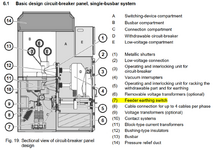obut4
Electrical
- Aug 29, 2007
- 35
Hello,
I would like your thoughts on the following situation.
We are about to order an Air-Insulated, Metal-Enclosed, Medium-Voltage Switchgear according to IEC 62271-200.
The switching-device compartments are equipped with withdrawable Vacuum circuit-breaker.
The feeder earthing switch can only be operated with switching device in disconnected Position.
My concern is about the Ike, tke and Ipe values for the earthing switch.
The switchgear data are following :
However, the design of the grounding switch has not changed and still maintains its performance at ik = 25 kA, tk = 3s."

Questions:
1. The system neutral earthing is implemented with a grounding resistance, which limits the phase-to-earth fault current to 738 A in the switchgear.
The value Ike and tke are relatively low.
Suppose the cable earthing switch is closed for maintenance and by mistake one phase is energized. This would be a direct phase to earth fault with the fault current limited to 738 A by the earthing system.
This far above the Ike = 60A et and Ipe = 150A.
Is the earthing switch correctly sized?
Is it safe?
2. Is ik = 25 kA, tk = 3s valid only if the three phases are energized ?
3. The earthing switch looks similar to earthing switch in switchgear from other manufacturer.
I could not find the value Ike and the in the datasheets.
Does it mean that they have better performances or that they didn’t evaluate this parameters?
Thanks for your help
I would like your thoughts on the following situation.
We are about to order an Air-Insulated, Metal-Enclosed, Medium-Voltage Switchgear according to IEC 62271-200.
The switching-device compartments are equipped with withdrawable Vacuum circuit-breaker.
The feeder earthing switch can only be operated with switching device in disconnected Position.
My concern is about the Ike, tke and Ipe values for the earthing switch.
The switchgear data are following :
- Installation: Indoor
- Number of phases: 3
- Busbar system: Single busbar
- Rated voltage: 24.0 kV
- Operating voltage: 16.0 kV
- Rated frequency: 50 Hz
- Rated short-time withstand current: 16 kA
- Rated duration of short-circuit: 1 s
- Rated peak withstand current: 40 kA
- Rated short-circuit breaking current: 16 kA
- Rated short-circuit making current: 40 kA
- Earthing switch with short-circuit making capability, Short-circuit current and duration: 25.0 kA / 3s
- Short-circuit current and duration:
- Rated short-time phase-to-earth withstand current (Ike): Ike = 60 A
- Rated duration of phase-to-earth short-circuit (tke): tke ≤ 24h
- Rated peak phase-to-earth withstand current (Ipe): Ipe ≤ 150 A
However, the design of the grounding switch has not changed and still maintains its performance at ik = 25 kA, tk = 3s."

Questions:
1. The system neutral earthing is implemented with a grounding resistance, which limits the phase-to-earth fault current to 738 A in the switchgear.
The value Ike and tke are relatively low.
Suppose the cable earthing switch is closed for maintenance and by mistake one phase is energized. This would be a direct phase to earth fault with the fault current limited to 738 A by the earthing system.
This far above the Ike = 60A et and Ipe = 150A.
Is the earthing switch correctly sized?
Is it safe?
2. Is ik = 25 kA, tk = 3s valid only if the three phases are energized ?
3. The earthing switch looks similar to earthing switch in switchgear from other manufacturer.
I could not find the value Ike and the in the datasheets.
Does it mean that they have better performances or that they didn’t evaluate this parameters?
Thanks for your help
